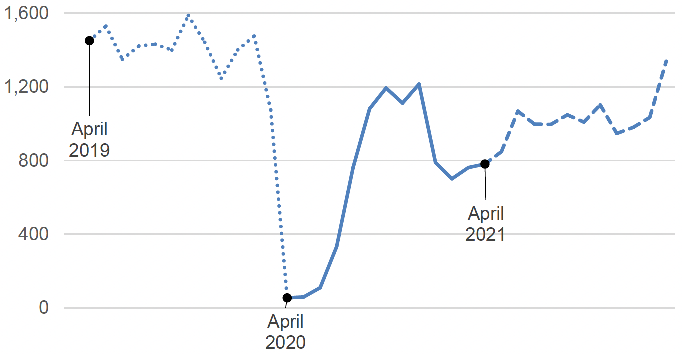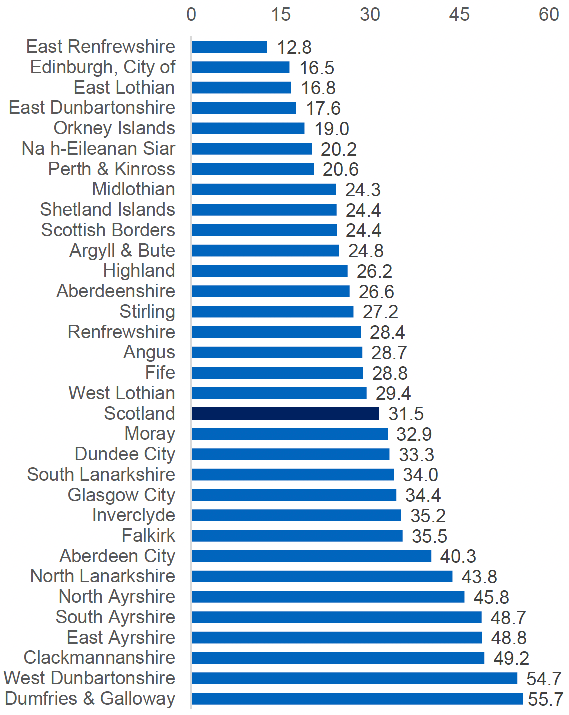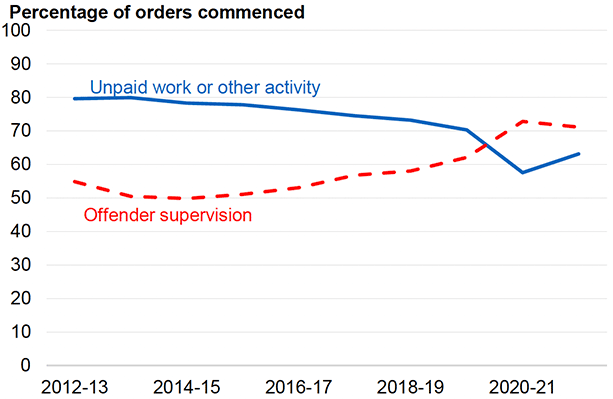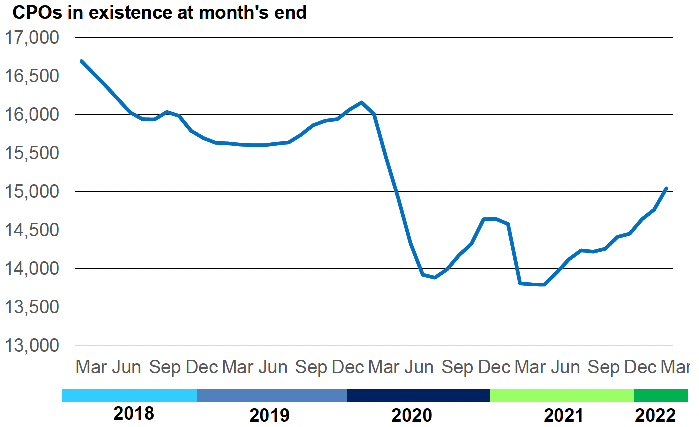Justice Social Work Statistics in Scotland: 2021-22
This publication presents national-level information on justice social work activity in Scotland. It includes data on justice social work services and social work orders, as well as characteristics of the individuals involved.
This document is part of a collection
5.2 Community payback orders
(Tables 2 & 8 to 17 and Charts 2-5)
5.2.1 There was a rise in the number of community payback orders (CPOs) in the initial years following their introduction. Numbers reached a peak of 19,500 in 2015-16. This was an expected rise, due to CPOs replacing legacy orders for offences committed on or after 1 February 2011. The total CPOs imposed then fell in the next three years to 16,500 in 2018-19, before a small rise to 16,800 in 2019-20. The COVID-19 pandemic and the resulting decrease in court business meant numbers fell sharply in 2020-21, to 8,200. Numbers then rose by 49 per cent in 2021-22 to the second lowest level in ten years of 12,200.
5.2.2 Chart 2 shows how numbers imposed by courts were lower in every month of 2020-21 than they were in the equivalent month in 2019-20. This was particularly the case during the period April to June 2020. The graph clearly shows the dramatic drop of CPOs imposed when COVID-19 related public health restrictions were at their highest level. Numbers during 2021-22 were more consistent from month to month but were still lower than in 2019-20 in every month except for the higher value in March 2022.

5.2.3 In 2021-22, there were 32 CPOs imposed per 10,000 population (Chart 3). This proportion was higher for Scotland and for every local authority area in 2021-22 than in 2020-21. The national rate in 2020-21 was 21 per 10,000 population but was much higher at 44 in 2019-20.
5.2.4 In 2021-22, the highest proportion per 10,000 population was for those living in Dumfries & Galloway (56), followed by West Dunbartonshire (55). The lowest proportions were for those living in East Renfrewshire (13) and City of Edinburgh (16). While the proportion for City of Edinburgh was much lower than for Scotland as a whole, the city council areas of Aberdeen (40), Glasgow (34) and Dundee (33) were each slightly higher than the national average. More detailed information by local authority area is in the additional datasets which accompany this publication.

Note: Population aged 16 to 70.
Requirements
(Tables 9 to 11 and Chart 4)
5.2.5 There are now ten potential requirements as part of a CPO at first imposition:
- Unpaid work or other activity
- Offender supervision
- Conduct
- Programme
- Alcohol treatment
- Compensation
- Drug treatment
- Mental health treatment
- Residence
- Restricted movement
Restricted movement requirements became available to issue at first imposition from 17th May 2022. This is outwith the period covered by this publication. Every order should have either or both an 'unpaid work or other activity requirement' or an 'offender supervision requirement'. In the remainder of this publication, these are referred to as unpaid work requirements and supervision requirements respectively.
5.2.6 For every year up to 2019-20, unpaid work was the requirement most commonly issued as part of a CPO. The proportion of orders with unpaid work was high in the early years after the introduction of the orders, and was 80 per cent in both 2012-13 and 2013-14. This then fell slightly in each of the next six years, reaching 70 per cent in 2019-20 (Chart 4). The prevalence then fell sharply to 58 per cent in 2020-21 before increasing slightly to 63 per cent in 2021-22.
5.2.7 The average number of hours given as part of unpaid work requirements rose from 124 hours in 2017-18 to 132 hours in 2021-22. Even though the proportion of CPOs imposed with an unpaid work requirement was the second lowest in ten years, changes in the length of hours have been occurring. In 2017-18, of 1,656,000 hours imposed, 29 per cent were for level 1 requirements (i.e. those with 100 hours or less). This proportion has dropped every year since then. In 2021-22, level 1 requirements were only 25 per cent of the 1,009,000 hours commenced.
5.2.8 In contrast, the proportion of orders with a supervision requirement has been rising over recent years, reaching 62 per cent in 2019-20 (Chart 4). The proportion then rose sharply in 2020-21 to 73 per cent and only fell slightly in 2021-22 to 71 per cent.
5.2.9 In the years 2017-18 to 2019-20, around or just less than 58 per cent of supervision requirements were for 12 months or less. This fell to 51 per cent in 2020-21 and then to 49 per cent in 2021-22. The average length of supervision requirements across 2017-18 to 2019-20 was around 15.5 months. It was, however, much higher in 2020-21 (16.7 months) and remained high in 2021-22 (16.9 months).

5.2.10 Chart 4 illustrates how much the composition of orders has changed since 2012-13. Greater use is being made of supervision and less is being made of unpaid work. In 2013-14, 80 per cent of orders had an unpaid work requirement and 50 per cent had a supervision requirement. By 2019-20, unpaid work remained the most common requirement, but it had fallen to 70 per cent. Supervision had risen to 62 per cent by this time. There was then a major change in 2020-21, the first year of the pandemic. The proportion with unpaid work dropped markedly to 58 per cent while those with supervision showed a big increase to 73 per cent. There was a slight reversal of this trend in 2021-22, with unpaid work rising to 63 per cent and supervision falling to 71 per cent.
5.2.11 The type of orders issued in both 2020-21 and 2021-22 was likely influenced significantly by the impact of the COVID-19 pandemic. Face-to-face delivery of unpaid work had to be suspended for some periods and courts would have been aware of the challenges of delivering unpaid work. Factors relating to the nature of cases which had court hearings during the pandemic, and the circumstances of the individuals involved, may also have been a relevant factor
5.2.12 After unpaid work and supervision requirements, conduct and programme have been the most commonly issued of the remaining requirements. The proportion of orders with conduct requirements has risen in each of the last five years from eight per cent in 2017-18 to 13 per cent in 2021-22. The proportion of orders with a programme requirement rose each year from 2017-18 (five per cent) to 2020-21 (nine per cent), before falling slightly to eight per cent in 2021-22.
5.2.13 The rest of the requirements were at around the same level in 2021-22 as 2020-21.
5.2.14 The average number of requirements per order has been steadily rising over the last five years. It increased from 1.50 in 2017-18 to 1.61 in 2021-22.
Characteristics
(Table 8)
5.2.15 In 2019-20, people aged 18 to 20 were the most likely, as a proportion of the overall population, to get a CPO. In 2020-21 and 2021-22 though, it was those aged 26 to 30 who were the most likely. In 2021-22, those aged 26 to 30 accounted for 17 per cent of people getting a CPO but only ten per cent of the Scottish population aged 16 to 70. Similarly, those aged 21 to 25 in 2021-22 accounted for 15 per cent of people getting a CPO but only nine per cent of the Scottish population aged 16 to 70.
5.2.16 People receiving CPOs have been getting slightly older in the last five years. In 2017-18, 31 per cent of orders were for people aged 25 and under. By 2021-22, this had fallen to 24 per cent. Those aged over 30 accounted for just over half of orders in 2017-18 but now account for 60 per cent in 2021-22. As a result, the average age of a CPO recipient has risen from 30 to 35 over the last ten years.
5.2.17 The proportion of CPOs issued to males has remained at 85 or 86 per cent over the last five years. Where ethnicity was recorded, over the last five years, 96 per cent classified themselves as white. For eight per cent of orders, the ethnicity was either not supplied or not known.
5.2.18 When employment status was known, 69 per cent of those receiving orders were either unemployed or economically inactive in 2021-22. A further 29 per cent were in employment or self-employed.
Orders in existence at year end
(Table 2)
5.2.19 The number of CPOs in existence increased by nine per cent during 2021-22, from 13,800 at 31 March 2021 to 15,000 at 31 March 2022. This was the third lowest figure in ten years. From 2012-13 to 2019-20, there was an average of 16,200.
5.2.20 Chart 5 shows how the numbers in existence changed throughout the last four years. Numbers fell during 2018 then rose slightly between the middle of 2019 and the start of the pandemic. They then went down sharply in the period between March and August 2020, reflecting the closure over this period of many courts (as seen in Chart 2). Numbers picked up during the rest of 2020 as more cases were processed by the courts. The drop between March and August 2021 was greatly influenced by The Community Orders (Coronavirus) (Scotland) Regulations 2021 coming into force. Under these regulations, the specified hours for existing orders with unpaid work or other activity requirements were reduced by 35 per cent (except for requirements imposed for offences involving domestic abuse, sexual offences or stalking). In some cases, this resulted in the requirement finishing on the date the regulations came into force. Between May 2021 and March 2022, the number of CPOs in existence showed a steady increase. However, at the end of that period, they were still lower than at the start of the pandemic in March 2020

Note: In order to better illustrate changes over the period covered by this graph, the vertical axis does not begin at number zero.
Timescales for implementation
(Tables 12 to 13)
5.2.21 The Scottish Government community payback order practice guidance supports practitioners and managers to improve their performance and work towards the achievement of the national outcomes and standards for social work services in the justice system. Further details on the guidance are in paragraph B.6 of Annex B.
5.2.22 First direct contact took place within one working day of imposition for 61 per cent of orders imposed in 2021-22 where this information was known. This was slightly higher than the level of 58 per cent in 2020-21, although it was still considerably lower than in the previous three years when it generally fluctuated around 75 per cent. In addition, in 2021-22, 20 per cent took more than five working days compared with 13 to 14 per cent across 2017-18 to 2019-20.
5.2.23 In 2021-22, where this information was known, 71 per cent of first induction/ case management meetings took place within five working days. This was slightly up on 2020-21 but lower than in the previous three years. Generally around 80 per cent took place within that timescale in each of the years 2017-18 to 2019-20. Roughly equal proportions (15 per cent) took six to ten working days and more than ten working days in 2021-22.
5.2.24 Where the timescale was known, 56 per cent of unpaid work placements started within seven working days in 2021-22. This was up on the low of 49 per cent in 2020-21 but still considerably lower than the levels of 2017-18 to 2019-20 which ranged from 68 to 73 per cent.
5.2.25 The lower proportions in 2020-21 and 2021-22 for these timescales were likely to have been influenced by the COVID-19 pandemic and related public health measures to keep people safe.
Terminations
(Tables 2 & 14 to 17)
5.2.26 The successful completion rate for CPOs terminated in 2021-22 was 74 per cent, similar to the rate of 75 per cent in 2020-21. These were higher than the rates in the previous five years when it was generally just under 70 per cent. The Community Orders (Coronavirus) (Scotland) Regulations 2021 coming into force is likely to have been a factor in this. The calculation of successful completion rates excludes CPOs that were terminated due to being transferred out to a different area.
5.2.27 In 2021-22, 12 per cent of orders terminated were revoked following a breach application to the courts. A further eight per cent were revoked following a review.
5.2.28 Seventy-nine per cent of orders which finished during 2021-22 did not involve any breach applications during the duration of the order. For the remainder, there were a total of 2,800 breach applications made. The vast majority of breach applications (79 per cent) were lodged with the court within five working days of the decision to make an application.
5.2.29 For CPOs revoked due to breach, the most likely outcome from courts were a new CPO at 29 per cent, "other" outcomes (e.g. admonishment, no further action etc.) at 28 per cent and a custodial sentence at 21 per cent. For orders revoked due to review, 14 per cent resulted in a custodial sentence. Another 20 per cent got a new CPO or a monetary penalty, while 43 per cent had an "other" outcome.
5.2.30 During 2021-22, a total of 5,500 unpaid work requirements were successfully completed. This was substantially higher than in 2020-21 (3,200). However, it was still low when compared with the previous three years, when levels ranged from 7,400 to 8,900. This reflects the fact that, in the last two years, there were fewer unpaid work requirements imposed and there were also issues impacting the delivery of unpaid work. Both of these relate to the impact of the coronavirus pandemic and related public health measures.
5.2.31 On average, there were 115 hours carried out for each requirement in 2021-22. This was much lower than in the previous four years. The Community Orders (Coronavirus) (Scotland) Regulations 2021 is likely to have been a factor in this.
5.2.32 It took a year on average to complete an unpaid work requirement in 2021-22. This was slightly shorter than in 2020-21 (403 days) but considerably longer than in the previous three years (between 214 and 226 days). This was expected given that the Coronavirus (Scotland) Act 2020 extended time limits for unpaid work in CPOs by 12 months, and required any new requirements made to be given at least 12 months to complete. This came into effect on 7 April 2020 and provisions were extended through to the end of September 2022 by the Coronavirus (Extension and Expiry) (Scotland) Act 2021.
Contact
Email: justice_analysts@gov.scot
There is a problem
Thanks for your feedback